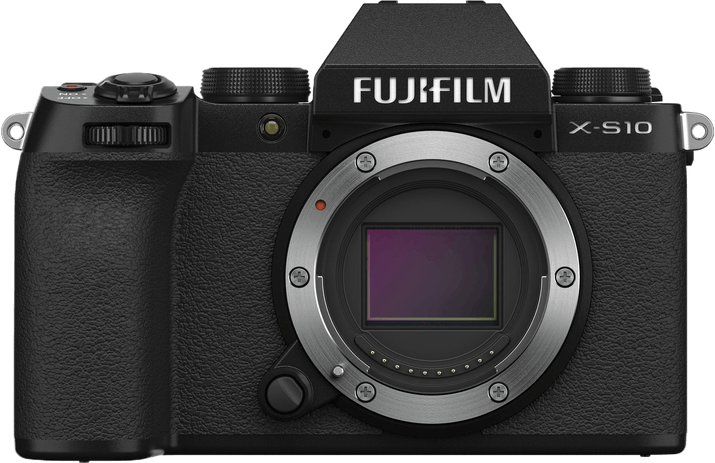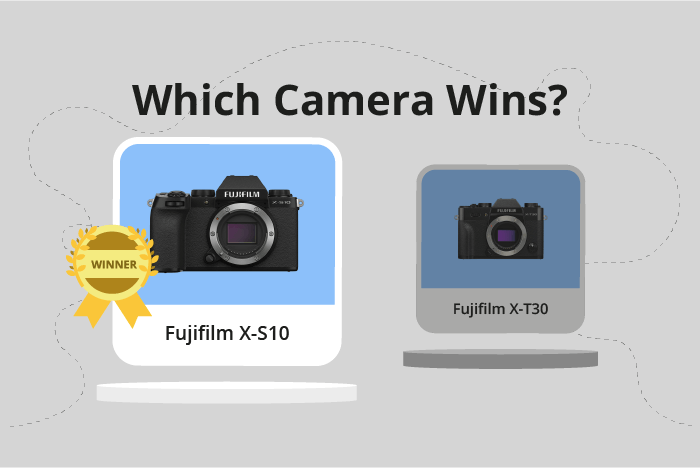Fujifilm X-S10 vs X-T30 Comparison
Fujifilm X-S10

Fujifilm X-T30

The Fujifilm X-S10 takes the lead with a score of 69/100, while the Fujifilm X-T30 trails behind at 65/100. Both cameras are mirrorless, released in 2020 and 2019 respectively. They share similarities in size, with the X-S10 measuring 126 x 85 x 65mm and the X-T30 at 118 x 83 x 47mm.
The X-S10 outperforms its counterpart with a higher score and a more recent release date. Priced at $999, it is slightly more expensive than the X-T30, which costs $899. The additional cost reflects the X-S10’s superior features and performance.
On the other hand, the X-T30 weighs less at 383g, compared to the X-S10’s 465g, making it a more lightweight option for users prioritizing portability. Despite its lower score, the X-T30 remains a viable choice for those seeking a more affordable and compact camera.
To sum up, the Fujifilm X-S10 is the better option with a higher score and more advanced features, while the X-T30 caters to those looking for a lighter and more budget-friendly alternative.
Fujifilm X-S10 vs X-T30 Overview and Optics
The Fujifilm X-S10 outperforms the Fujifilm X-T30 in optics with a score of 72/100, compared to the X-T30’s 67/100. Both cameras share several common specifications, including 26 megapixels, CMOS sensor type, X-Processor 4, APS-C sensor size, and Fujifilm X lens mount. Additionally, DXOMARK does not score the sensors for either camera.
The X-S10 stands out with its image stabilization feature, which the X-T30 lacks. This advantage allows the X-S10 to capture sharper images in various shooting conditions, particularly in low light or when using slower shutter speeds. Consequently, photographers can expect better image quality and versatility from the X-S10.
On the other hand, the X-T30 has a higher shooting speed of 30 frames per second (fps), compared to the X-S10’s 20 fps. This difference makes the X-T30 better suited for capturing fast-moving subjects and action scenes. However, the lack of image stabilization might affect the sharpness of these fast-paced shots.
In terms of optics, the Fujifilm X-S10 is the better choice due to its image stabilization feature, which significantly contributes to overall image quality. The X-T30’s advantage in shooting speed is noteworthy, but without image stabilization, its potential for capturing sharp images in demanding situations is limited. Therefore, the X-S10’s superior optical performance makes it a more versatile and reliable option for photographers.
Fujifilm X-S10 vs X-T30 Video Performance
The Fujifilm X-S10 and Fujifilm X-T30 both have a video score of 91/100, making them equally strong contenders in the video department. They share several common video specifications, such as a maximum video resolution of 4K and maximum video dimensions of 4096 x 2160. Additionally, both cameras have built-in time-lapse functionality, which is useful for creating dynamic and visually appealing video content.
The Fujifilm X-S10 edges out the X-T30 in terms of video frame rate, offering a maximum of 240fps while the X-T30 only reaches 120fps. This higher frame rate allows the X-S10 to capture smoother slow-motion footage, making it a more versatile option for videographers who require this feature in their work.
On the other hand, the Fujifilm X-T30 does not have any significant advantages over the X-S10 in the video department. Both cameras share the same score and most of the same specifications, which means that the X-T30 is not lacking in any major way when compared to the X-S10.
Given these points, it is clear that the Fujifilm X-S10 is a slightly better choice for video capabilities due to its higher maximum frame rate. This advantage allows for smoother slow-motion footage, which can be an important factor for videographers. However, the Fujifilm X-T30 remains a strong contender in this area, as it shares most of the same video specifications as the X-S10. Therefore, both cameras are suitable options for those looking to capture high-quality video content, with the X-S10 being slightly more versatile in terms of frame rate.
Fujifilm X-S10 vs X-T30 Features and Benefits
The Fujifilm X-S10 and X-T30 cameras tie in features with a score of 70/100 each. Both cameras share several specifications, such as a 3-inch screen size, a screen resolution of 1040000 dots, a touchscreen, a flip screen, and the absence of GPS. They also have Bluetooth connectivity.
The Fujifilm X-S10 and X-T30 differ in the presence of WIFI. The X-T30 has WIFI, giving it an advantage over the X-S10, which lacks this feature. WIFI allows for easier file transfer and remote control of the camera, making the X-T30 more convenient for photographers who need to share their work quickly or control their camera from a distance.
However, the X-S10 does not have any specific feature that makes it better than the X-T30. The absence of WIFI is the only difference between the two cameras in terms of features, with the X-T30 coming out on top in this aspect.
Considering the similarities and differences between the Fujifilm X-S10 and X-T30, it becomes clear that the X-T30 has a slight edge over the X-S10 due to its WIFI capability. This added feature makes the X-T30 more versatile and convenient for photographers who need to transfer files quickly or control their camera remotely. On the other hand, the X-S10 does not have any distinct advantage over the X-T30, making it a less preferable choice for those who require WIFI connectivity. Despite the tie in overall feature scores, the X-T30’s WIFI capability makes it a better option for photographers seeking more advanced connectivity features.
Fujifilm X-S10 vs X-T30 Storage and Battery
The Fujifilm X-S10 and X-T30 both have a storage and battery score of 35/100. They share similarities in storage options, with each camera possessing a single memory card slot, accepting SD, SDHC, and SDXC cards (UHS-I compatible). Both cameras also have USB charging capabilities.
The Fujifilm X-T30 has a slight advantage in battery life, offering 380 shots compared to the X-S10’s 325 shots. This difference is due to the X-T30’s NP-W126S battery type, which provides more power than the X-S10’s NP-126S battery. This longer battery life can be beneficial for extended shooting sessions.
On the other hand, the Fujifilm X-S10 does not offer any advantages in storage and battery over the X-T30. The two cameras share identical storage options and features, with the X-T30 having a marginally better battery life.
Considering the storage and battery aspects, the Fujifilm X-T30 proves to be a slightly better option due to its longer battery life. However, both cameras offer similar storage capabilities, making the choice between them dependent on the user’s priority on battery life.
Alternatives to the Fujifilm X-S10 and X-T30
Are you still undecided about which camera is right for you? Have a look at these popular comparisons that feature the Fujifilm X-S10 or the Fujifilm X-T30:

